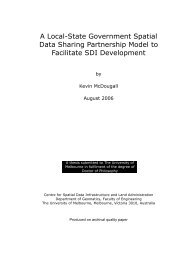The Danish Way - Centre for Spatial Data Infrastructures and Land ...
The Danish Way - Centre for Spatial Data Infrastructures and Land ...
The Danish Way - Centre for Spatial Data Infrastructures and Land ...
Create successful ePaper yourself
Turn your PDF publications into a flip-book with our unique Google optimized e-Paper software.
<strong>The</strong> analysis of the <strong>Danish</strong> LAS builds on the L<strong>and</strong> Management Paradigm in which l<strong>and</strong><br />
administration is seen as an area dealing with rights, restrictions <strong>and</strong> responsibilities in<br />
l<strong>and</strong>. This relates to the interaction of the three areas of l<strong>and</strong> tenure, l<strong>and</strong> value <strong>and</strong> l<strong>and</strong><br />
use. By including l<strong>and</strong> development these four areas are called the L<strong>and</strong> Administration<br />
Functions. <strong>The</strong>se functions are based on policies determining the overall objectives <strong>and</strong><br />
they are managed on the basis of appropriate l<strong>and</strong> in<strong>for</strong>mation infrastructures providing<br />
complete <strong>and</strong> up to date in <strong>for</strong>mation on the natural <strong>and</strong> built environment. This all sits<br />
within a country/state context of institutional arrangements that may change over time. <strong>The</strong><br />
Paradigm is presented in Figure 1 below (Enemark et al., 2005):<br />
<strong>The</strong> L<strong>and</strong> Policy Component<br />
E-Government E-Citizenship<br />
Figure 1. <strong>The</strong> L<strong>and</strong> Management Paradigm<br />
L<strong>and</strong> policies are expressed partly through the constitution <strong>and</strong> other more general laws<br />
such as the L<strong>and</strong> Registry Act, <strong>The</strong> Subdivision Act, <strong>The</strong> Valuation Act, <strong>and</strong> the Planning<br />
Act, <strong>and</strong> partly through the sectoral l<strong>and</strong>-use acts such as the Agricultural Holdings Act, the<br />
Environmental Protection Act, <strong>and</strong> the Nature Protection Act.<br />
A key l<strong>and</strong> policy is laid down in the Planning Act that establishes a general zoning<br />
dividing the total country into urban, recreational <strong>and</strong> rural zones. This provides a low l<strong>and</strong><br />
value in rural areas, where no developments are allowed except <strong>for</strong> agricultural <strong>and</strong> <strong>for</strong>estry<br />
purposes. <strong>The</strong> provisions on rural zones, covering about 90% of the country, are intended to<br />
provide a clear delimitation between town <strong>and</strong> country, to prevent urban sprawl <strong>and</strong><br />
uncontrolled l<strong>and</strong> development in the countryside, <strong>and</strong> to preserve valuable l<strong>and</strong>scapes. In<br />
urban areas, the l<strong>and</strong>-use opportunities are determined by planning regulations at local<br />
4







